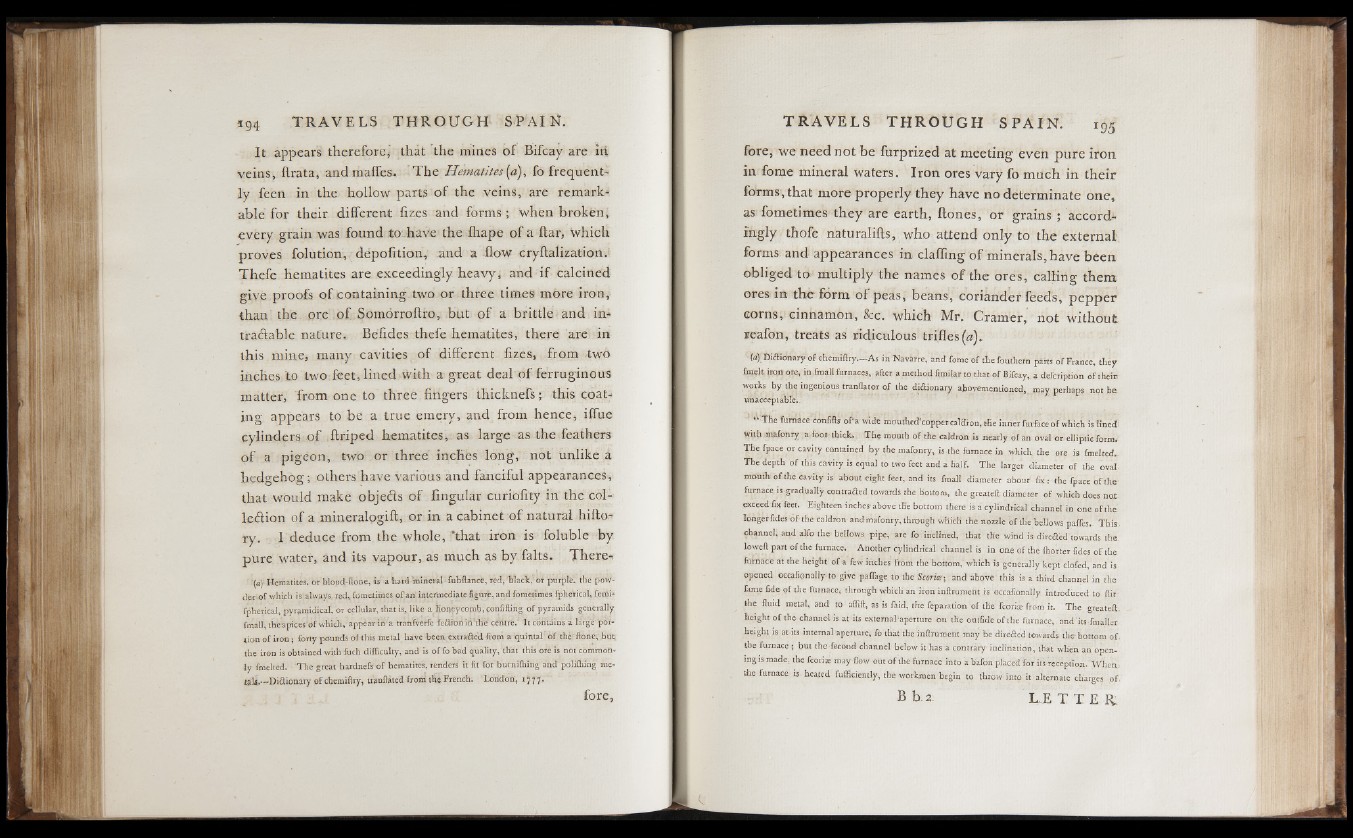
It appears therefore,’ that the mines of Bifcay are in
veins, iirata, andmaffes, The Hematites [a), fo frequently
feen in the hollow parts o f the veins, are remarkable
for their different fizes and forms ; when broken,
every grain was found to have the ihape of a ftar, Which
proves folution, dépoiition, and a -flow cryftalization.
Thefe hematites are exceedingly heavy ; and if calcined
give proofs of containing.two or three times more iron,
than the ore of Somorroftro, but of a brittle and intractable
nature. Beiides thefe hematites, there are in
this mine, many cavities of different fizes, from two
inches to two feet, lined with a great deal of ferruginous
matter, from one to three fingers thicknefs ^ this coating
appears to be a true emery, and from hence, iffue
cylinders o f ftriped hematites, as large as the feathers
o f a pigeon, two or three inches long, not unlike â
hedgehog; others have various and fanciful appearances,
that would make objecls of lingular curiofity in the col-
leftion of a mineralogift, or in a cabinet of natural hifto-
ry. I deduce from the whole, ‘that iron is foluble by
pure water, and its vapour, as much as by faits. There-,
•(a) Hematites, or blood-fione, is a bard Wmeral - iubftance, red, black, br purple; the poW-
der-of which is'always, red, fometimes o fan intermediate figure, and fometimes fpherical, femi-
fjjhevical, pyramidical, or cellular, that is, like a Honeycomb, confifting of pyramids generally,
fmall, theapices Of w hich,- appèarin’a tranfveHe Îe&iohifi'thë* çèhfrë. It coHtâins â làrge 'pof-
*ion of iron; forty pounds of this metal have been, extracted from a quintal1 i f thèftonec.biit;,
the iron is obtained with fuch difficulty, and is of fo bad quality, that this ofê is not commonly
fmelted. - The great hardnefs o f hematite's, renders it fit for burnifhirig and poliihing me*
tak.- -Diûionary of chemiftry, tranflàted froni thé French. Loiidôû’, 1777.
fore,
fore, we need not be furprized at meeting even pure iron
in fome mineral waters. Iron ores vary fo much in their
forms, that more properly they have no determinate one,
as fometimes they are earth, ftones, or grains ; accordingly
thofe naturalifts, who attend only to the external
forms, and appearances in claffing o f minerals, have been
obliged to multiply the names o f the ores, calling them
ores in the form o f peas, beans, coriander feeds, pepper
corns; cinnamon, 8cc. which Mr. Cramer, not without
reafon, treats as ridiculous trifles (a).
(afDiaidmryo f chemiftry.—As in N a v t e e .W foiaedi the fouthern parts of France^ they
fmelt iron ore, in,fmall furnaces, after a method fimilar to that of Bifcay„a defcription of their
works b y the ingeni.ous tranflator of Ahe diffionary abovementioned,, may perhaps not be
unacceptable..
P “ The funiice cdnfifts- ofSrwicie mbuthecrcopper caldron, the inner furface o f which islineii
with .mhfonry a foot thick.. The mouth of the caldron is nearly of an oval or elliptic form..
The fpace or cavity contained by the mafonry, is the furnace in which, the ore is fmelted..
The depth o f this cavity is equal to two feet and a Half. The larger diameter of the oval
month: of.the cavity isi about eight feet,and its fmall diameter about' fix : the fpace o f the
furnace is gradually contrafied towards the Bottom, the greateft diameter of which does not:
exceed fix feet. Eighteen incbes-above the bottom there is a cylindrical channel in one. of the',
longer fides of, the caldronandmafonry, through which the ndzzle Of the bellowspaffes.. This,
channel; and alio the’ bellows pipe, are fo ; inclined, that the wind "is dired'ed towards the.
loweft part of the furnace.. Another cylindrical channel is in one of the ihorter fides o f the
furnace at the height of a few inches from the bottom,'which is ‘generally kept dofed, and is
opened oceafionally to give paifage to the Scon®; . and above this is a third channel in the
fame fide of the furnace,- through which an iron inftrument is oceafionally introduced to ftir
the fluid metal, and to aflift, as is laid, the feparation of th'e fcorise from it. The greateft
height o f the channel is at its external’aperture 011 the outfide of the furnace, . and its fmaller
height is at,its internal aperture, fo that the inftrument may be direfled towards the-bottom of.
the furnace ; but the feeond channel below it has a contrary inclination, that when an opening
is made, the fcorire may flow out of the furnace into a b’afon placed for its reception. When,
the furnace is heated fufficiently, the workmen begin to throw into it alternate charge, of,
B b. 2- L E 1 ’ T E R